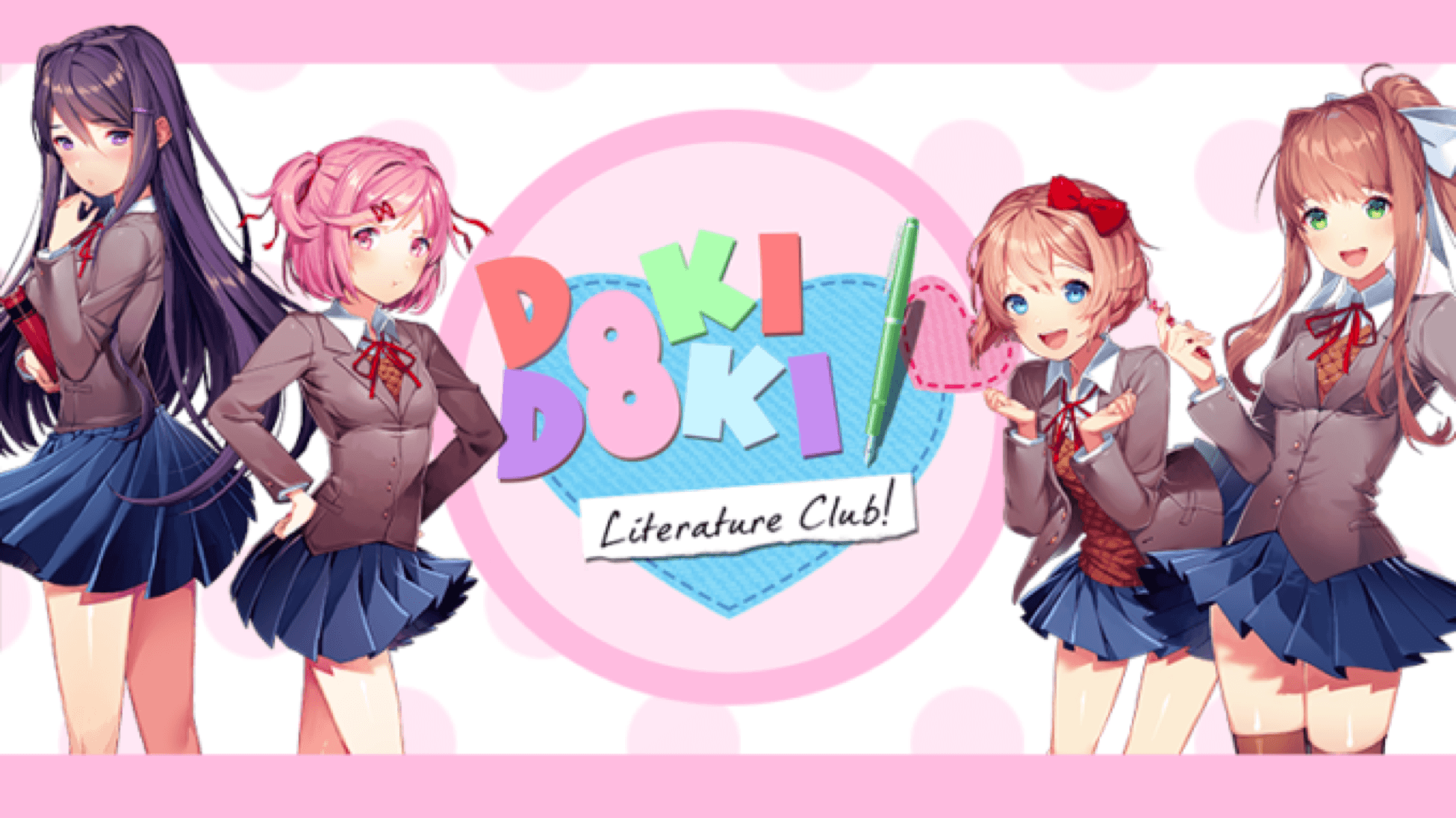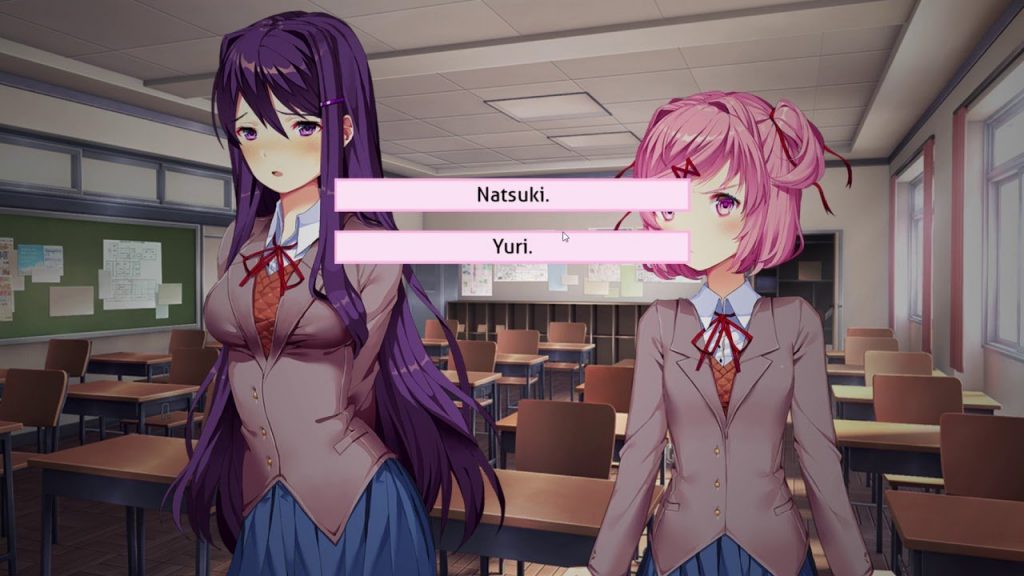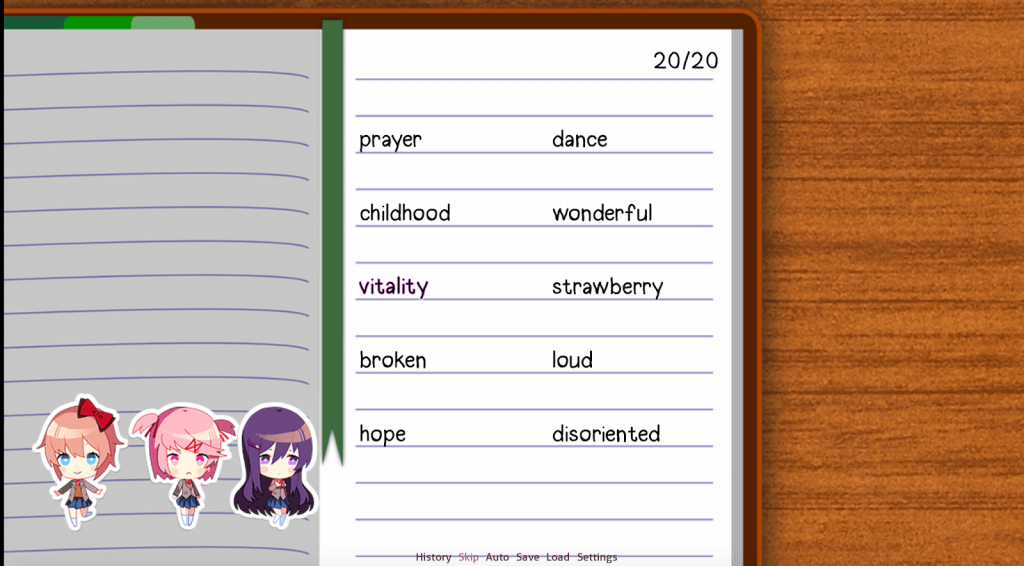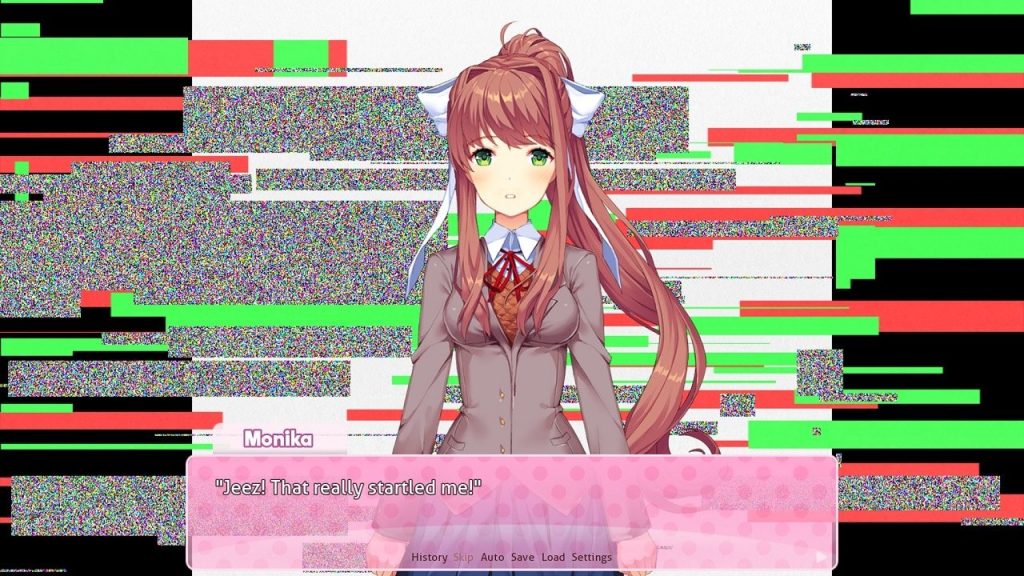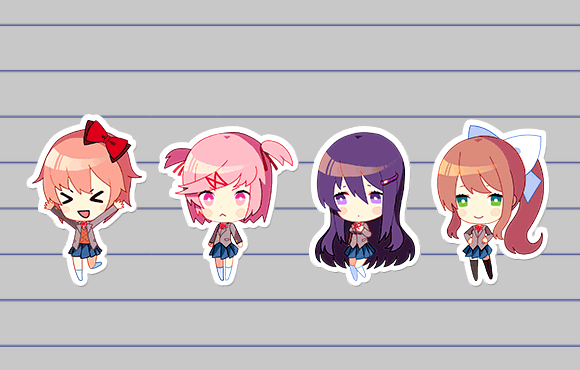Doki Doki Literature Club (DDLC) is a visual novel created by Team Salvato, a game development studio founded in 2017 by Dan Salvato. It has the premise of a dating simulation game.
Introduction
You play as the male protagonist who is invited by your obnoxious childhood friend, Sayori, to join the club of which she is the vice-president: the Literature Club. You reluctantly agree in hopes of quieting her down. In the club, you meet three other girls–Natsuki, the petite girl who can’t be honest sometimes; Yuri, the sophisticated girl with a taste for mysteries; and Monika, the popular and dependable club president.
Gameplay
It’s mostly text-based (since it’s a visual novel), but there are some interactions. You can gain favor from the girl of your choice by choosing them directly when prompted to (e.g. when being asked who you want to help, etc) and by creating poems. Since it is a Literature Club, you will have a “homework” of creating a poem every day. The way you create poem is by choosing the words you want from several lists of words. Different words will appeal to different girls; for example, the mature girl will prefer complicated words, and the cute girl will prefer fluffy, simple words.
The next day, in the club, you can show your poem to the girls and they will give their opinions on it (depending on what words you chose). As they develop better opinion of you, you will get to know them better.
[Just a thought: they call it a “Literature Club” but really, it’s more of a “Poem Club” since all they make are poems.]
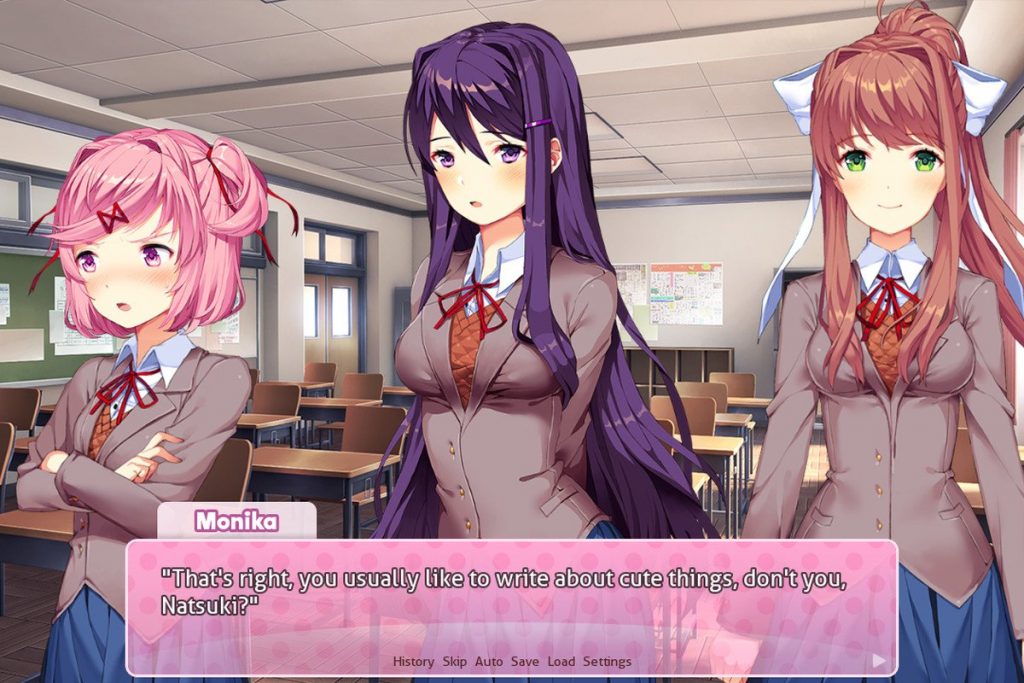
Screenshot of the gameplay. [https://www.polygon.com/2017/10/22/16512204/doki-doki-literature-club-pc-explained]
Twist
However, as you progress through the game, you will find out the darker side of the characters. You find out in the end that their issues are “triggered” and even “enhanced” by Monika, who is aware that all of them are in some kind of a dating game. Some of the characters end up dead in less than pleasant ways because of that.
In the game, Monika does not have a route–you cannot “get together” with her. Monika poses questions about the culture of dating games; why do the characters not have any “choice” whether they want the protagonist or not? Why are the characters always so obsessed with the protagonist? And she will mention that she does what she does to the other characters because she falls in love with you, which inevitably makes the audience sympathize with Monika. However, is that really justifiable for her to drive her friends to the brink of madness, just because the world is “unfair”?
Visual
The color palette of this game consists mostly of bright pastel colors, which enhances the cute and comforting mood. The contrast then becomes stronger compared to the moment after the story takes a dark turn, where the visuals will change. At first the change will be small and unnoticeable; the screen turning red for a split second or a very quick glitch moment. But then it will grow to be something bigger; change of fonts, change of the characters’ personality or appearance, etc.
I feel that those small changes can give a lot of impact; it unsettles the players in a subconscious way, compared to a direct way where a bloody dead person is shown on the screen. (Although this game definitely has the direct way as well.)
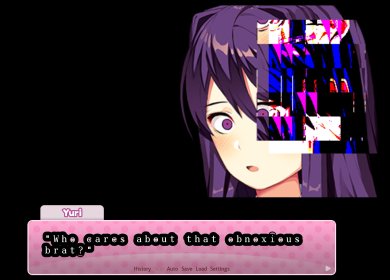
[https://www.quora.com/Why-do-you-think-the-Doki-Doki-Literature-Club-is-scarier-unlike-any-other-typical-horror-game]
Music
Paired with the visuals, the music also starts off bright and cheerful, and slowly changes. The song is the same, but there is slight changes in the tempo, key, and volume that, again, subconsciously unsettle players.
Characters
All the characters in this game have so-called problems. Sayori has depression, Yuri is obsessed and enjoys cutting herself, Natsuki is abused by her father, and Monika is obsessed with the protagonist to the point that she deletes her friends’ character files so she can monopolize the protagonist.
Those make the characters feel more realistic. They all still some kind of cookie-cut personalities or archetypes–which is totally fine, since there is no such thing as an original personality anyway. But what defines them is how they interact with each other and how they act to handle their so-called problems. Through their different ways of coping, audience can readily relate and sympathize. That’s why I think the characters in this game are very well fleshed out, and although the concept of the story itself is not new, the characters can make the story good. It makes me think that a narrative doesn’t have to be complicated, as long as you can find a mean to make people relate in some ways to the narrative–in this game, through the characters and the difficulties they face.
Use of Files
In order to progress with the game, at a certain point, you have to open the game’s files and delete a file. Moreover, if you open some of the files, they will show special images that you won’t see in the game, or descriptions that hint at the idea that someone is breaking the fourth wall. I think it’s an effective and interesting way to show that a character is “self-aware” instead of just showing a monologue like “I feel like someone is controlling us”.
However, the downside is that players may not be aware of this. It’s not common for people to open up the game’s files while playing or actively altering the files as a part of the gameplay. I think it robs some level of excitement when you have to research to find out how to progress in the game. Some people who are not aware of that just leave the game in the loop, unknowing that you can actually progress, because the loop does look like a proper ending. (It is the so-called “bad ending”.)

In order to progress, you need to delete Monika’s file at one point. [https://gameplay.tips/guides/1299-doki-doki-literature-club.html]
Interactivity
Since it is a visual novel, the interactivity is definitely lacking. However, aside from that, the thing that I find a bit tedious about this game is its nature of repetition.
In order to fully understand the game or to get the “true” ending, you will have to play the game more than once–ideally three times. Since this is a text-based visual novel, the texts and conversations can be chunky to the point that I feel they are dragging the gameplay. There is an option to skip the texts, but they might also skip the small changes in the unread dialogues, resulting in you skipping things you don’t know. However, contrary to my opinion, some people actually say that they wish there is more time for them to interact with the girls.
In addition, there is a very fixed way to playing this game–in order to progress, you have to do this exact action, and you have to do this, and so on.
The choices you made matter very little since it only has one fixed ending. Moreover, since the gameplay was making poems but the ending has nothing to do with that, it makes me wonder what the point of the entire interaction is.
Theme
Besides addressing the problem with dating games, the game also touches on the subject of mental health issues. Sayori, is suffering from depression. Dan Salvato based her on his own acquaintance who suffered from depression, making her character’s emotions and expressions highly realistic and even relatable to a certain degree.
Since the game is not promoted as something about mental health, I think it will expose more about that to people who are not interested in understanding mental health in the first place. Sayori uses simple expressions to try to explain her depression. I think that’s an effective way to show people what depression actually feels like, and actually intrigues people to learn more about mental illnesses.
“People become disturbed when forced to think about things they don’t want to, or shown a reality that they always try to ignore,” he said. “But humans aren’t rational creatures. It’s when we’re emotionally charged that we become inspired to do something for ourselves, or for others.”
-Dan Salvato, taken from an interview with Kotaku
Since this game contains disturbing contents, there are warnings at the beginning of the game and even in the download page. However despite of those, children and people who are easily triggered still play it anyway. Firstly, because they are curious. Secondly, because it “doesn’t look that bad”.
Dan Salvato made this game out of his “love-hate relationship with anime” as he wanted to address the culture of anime–cute, moe stuffs. He always liked things that take a sudden dark turn and he integrated it into DDLC. But looking at how people think that “it won’t be that bad because it has a cute interface”, is it wrong of him to do so? Can it be considered false advertisement, even if he already explicitly put warnings?
Conclusion
All in all, I think DDLC is a good visual novel. It certainly sticks with me. It evokes a lot of emotions–especially sympathy for Sayori who committed suicide in the end due to her depression. In the story, regardless of whatever you said to her, you won’t be able to save her. That’s sad, but it’s honestly realistic. It makes me feel sympathetic towards people who are suffering from mental illnesses.
I even sympathized with the “villain”, Monika. What she does isn’t justifiable, but she is just trying to achieve her dream. The world is unfair, but do we have to accept that as a fact, or does everything we can to deny that? And when we do try to deny that, where do we draw the line between “acceptable” and “unacceptable” effort?
The game is long, and tedious sometimes. I can only play it all the way through because I watched a playthrough and I just want to experience it myself. But in the end, since watching the playthrough makes me want to play it myself… I guess in a way, it is a “good” game then.
